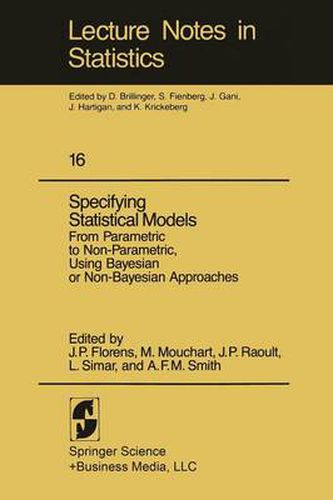Readings Newsletter
Become a Readings Member to make your shopping experience even easier.
Sign in or sign up for free!
You’re not far away from qualifying for FREE standard shipping within Australia
You’ve qualified for FREE standard shipping within Australia
The cart is loading…






This title is printed to order. This book may have been self-published. If so, we cannot guarantee the quality of the content. In the main most books will have gone through the editing process however some may not. We therefore suggest that you be aware of this before ordering this book. If in doubt check either the author or publisher’s details as we are unable to accept any returns unless they are faulty. Please contact us if you have any questions.
During the last decades. the evolution of theoretical statistics has been marked by a considerable expansion of the number of mathematically and computationaly trac table models. Faced with this inflation. applied statisticians feel more and more un comfortable: they are often hesitant about their traditional (typically parametric) assumptions. such as normal and i. i. d . * ARMA forms for time-series. etc . * but are at the same time afraid of venturing into the jungle of less familiar models. The prob lem of the justification for taking up one model rather than another one is thus a crucial one. and can take different forms. (a) ~~~GBPifi~~~ iQ~ : Do observations suggest the use of a different model from the one initially proposed (e. g. one which takes account of outliers). or do they render plau sible a choice from among different proposed models (e. g. fixing or not the value of a certai n parameter) ? (b) tlQ ~~L~~ l!rQ1!iIMHQ~ : How is it possible to compute a distance between a given model and a less (or more) sophisticated one. and what is the technical meaning of such a distance ? © BQe ~~~~~~ : To what extent do the qualities of a procedure. well adapted to a small model. deteriorate when this model is replaced by a more general one? This question can be considered not only. as usual. in a parametric framework (contamina tion) or in the extension from parametriC to non parametric models but also.
$9.00 standard shipping within Australia
FREE standard shipping within Australia for orders over $100.00
Express & International shipping calculated at checkout
This title is printed to order. This book may have been self-published. If so, we cannot guarantee the quality of the content. In the main most books will have gone through the editing process however some may not. We therefore suggest that you be aware of this before ordering this book. If in doubt check either the author or publisher’s details as we are unable to accept any returns unless they are faulty. Please contact us if you have any questions.
During the last decades. the evolution of theoretical statistics has been marked by a considerable expansion of the number of mathematically and computationaly trac table models. Faced with this inflation. applied statisticians feel more and more un comfortable: they are often hesitant about their traditional (typically parametric) assumptions. such as normal and i. i. d . * ARMA forms for time-series. etc . * but are at the same time afraid of venturing into the jungle of less familiar models. The prob lem of the justification for taking up one model rather than another one is thus a crucial one. and can take different forms. (a) ~~~GBPifi~~~ iQ~ : Do observations suggest the use of a different model from the one initially proposed (e. g. one which takes account of outliers). or do they render plau sible a choice from among different proposed models (e. g. fixing or not the value of a certai n parameter) ? (b) tlQ ~~L~~ l!rQ1!iIMHQ~ : How is it possible to compute a distance between a given model and a less (or more) sophisticated one. and what is the technical meaning of such a distance ? © BQe ~~~~~~ : To what extent do the qualities of a procedure. well adapted to a small model. deteriorate when this model is replaced by a more general one? This question can be considered not only. as usual. in a parametric framework (contamina tion) or in the extension from parametriC to non parametric models but also.